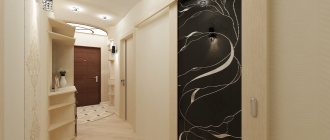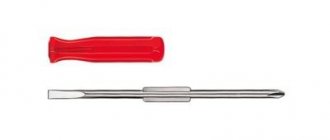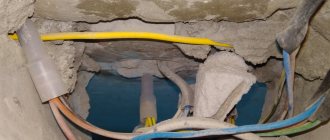A wireless light switch remotely turns on or off the light, changes the brightness of the light and controls the delay of operation of electric lamps.
Despite their higher cost, wireless switches have a number of advantages over their wired counterparts. They are ergonomic, have a stylish appearance and can be installed within a few minutes. There is no need to damage the walls, since these products are securely attached to the side of the cabinet, mirror, and other furniture.
Design and principle of operation of a wireless switch
A wireless remote switch (WRS) consists of a transmitter that converts the control signal into a radio signal from a master oscillator. This happens after pressing the switch key, touching the touchpad, or sending a signal from the phone via WI-FI. In the transmitter's coverage area there is a receiver (actuator) that “closes ↔ opens” the contacts of the power relay connected to the power circuit break at the moment the radio signal is received. In addition to the radio frequency of 315 MHz or 433.92 MHz, infrared waves are also used for signal transmission.
What to consider before purchasing?
You should purchase a wireless module in a specialized store, taking into account such product characteristics as:
- type of light bulbs available for control;
- dimensions and general appearance of the product (material from which the case is made, color scheme, shape and number of keys);
- operating voltage range;
- number of channels;
- signal coverage radius;
- maximum permissible load during operation;
- rated current level;
- factory equipment;
- list of operating frequencies;
- method of transmitting a command signal;
- encoding (presence or absence);
- type of power supply for the transmitter (generator, battery);
- the period declared by the manufacturer for which the battery capacity is sufficient;
- principle of mounting the device;
- price.
Additionally, you need to find out from the seller what warranty period the manufacturer provides for the product and where the service centers are located. Complete information will help you make the right choice and purchase exactly the model that will satisfy the buyer’s requirements for the device in all respects.
Varieties
Wireless switches are classified according to three main characteristics:
- Lighting control method. Devices offered in trade today are equipped with push-button or touch switches and remote controls.
- Possibility of smooth adjustment of the light flow. The lighting intensity is changed by long pressing a special button on the device with a built-in dimmer.
- Number of controllable lighting fixtures. There are wireless DVs designed for 1-2-3 or more groups of lamps with different numbers of lamps.
Using additional options allows you to configure the command execution delay function for several seconds. It allows, for example, the user to perform a series of actions with the lights on until the room is plunged into complete darkness.
With remote control
Along with built-in switches, remote control of individual lighting devices or large groups of lamps can be carried out using a push-button key fob or remote control.
There are two buttons on the remote control for each channel. One turns on the power supply and increases the brightness of the glow, the other reduces the light intensity or turns off electrical appliances. The load is turned on/off by briefly pressing the button for 0.1–1 s, and the luminous flux is adjusted by holding the same button for more than 1 second. Screws for wall mounting of the accessory are included in the factory package.
Multi-channel radio switch
In a multi-channel radio switch, it is possible to configure up to 8 channels connected to the lighting system. This allows you to control the lighting in the entire apartment or rooms in the house.
To avoid confusion, radio switches remember the addresses of exclusively “native” remote controls and execute only commands of their bitrate.
It is set by a certain speed of transmission and reception of information, measured in kbit/s, while the frequency of the transmitted signal of 30-40 kHz remains unchanged. The basis of each remote control is a pulse generator, the signal of which is modulated by the code of a specific command. An incomplete remote control can be untied and linked to the device if its unique number matches the same switch code.
Touch panels
Externally, the touch panel is a crystal glass screen with applied markings, visualized by backlighting. By briefly applying your finger, switching is carried out, and by holding it in the designated place on the panel, the illumination is adjusted with a dimmer. The human capacitance introduced by contact changes the parameters of the capacitor in the electrostatic field, a control signal is generated, from which the switch switching circuit is launched. The absence of mechanical keys in the design increases the service life of wireless DVs to 100 thousand activations.
Wi-Fi or RF
The presence of a Wi-Fi extension in a smartphone, tablet or computer with Internet access allows you to control the lighting using the gadget in a similar way to a remote control. When you send a certain command from the gadget after clicking on the device icon and the corresponding action icon in it, the transmitter generates a pulse. It is then converted into a 2.4 GHz or 5 GHz radio frequency signal from the Wi-Fi router, which is picked up by the device's receiver within the router's coverage area.
Smart home equipment for apartments: light control via the Internet
The availability of this method is based on the fact that the remote lighting control scheme is based on the use of devices that already work in most of our apartments.
State-owned information technology companies have long provided most residents with unlimited Internet that operates around the clock.
I purchased smart home equipment for an apartment in China from Sonoff. Next I show how the remote lighting control scheme works via the Internet from a smartphone.
The kit includes a Sonoff smart switch and a small key fob remote control.
In principle, all work via the Internet occurs through a smartphone, and the remote control is only needed to switch the lights inside the apartment. Although even in this case you can get by with your mobile phone.
It’s just convenient to keep the key fob remote control in one place; all family members, including children, can use it. In addition, it works regardless of the presence of WiFi.
Now I do not intend to fully describe the settings of the smartphone and the connection of its circuit to the smart switch, but will focus on the difficulty that I had to face when installing the module in the old installation box.
My apartment is located in a multi-storey panel building built in Soviet times. For electrical wiring, the factory immediately created channels for laying cables.
They are located at arbitrary angles, often in the most inconvenient places for installation: literally in the recess at the junction of the wall and the ceiling slab. A channel for switches or socket groups runs downwards from it obliquely.
The old switch connection diagram is based on breaking only the phase wire. Therefore, the zero potential is not drawn there.
However, a Sonoff smart switch without zero potential will not work. I had to pull it there through an inclined channel.
When I removed the old switch housing, I saw an ordinary aluminum noodle - 2 wires. Then he climbed into the junction box, if that’s what you can call the place where the slabs join, which was covered with small gravel with scraps of newspapers and pieces of concrete.
I saw a tangle of twisted wires and black electrical tape. The voltage indicator and digital multimeter helped quickly understand the purpose of each connection.
It turned out to be a problem to insert an additional core of zero potential. The crushed stone and cement dust firmly filled the entire space of the cable channel.
Even attempts to pass through this composition with a rigid steel wire were unsuccessful. And inside the room, cosmetic work was recently carried out and new wallpaper was installed. I didn't want to stir up any dirt.
I used the old trick:
- Turned off the light in the apartment panel.
- I taped a piece of copper cable with three cores to the lower end of the old two-core wire with strong electrical tape.
- I inserted pliers with long jaws into the ceiling cavity and clamped them with the top piece of aluminum noodles, because it is impossible to pull it there with your fingers.
- I began to little by little wind the wire onto the pliers and remove the debris that was coming out of the channel, afraid that it would break. But it worked out.
In this way, it was possible to pull a new cable through the littered main and remove several handfuls of small stones from it. Why were they put there? I don't have an answer to this question.
I hope that my experience will be useful to someone.
By the way, much of the equipment from Nootekhnika: Belarus also allows you to control the light remotely via the Internet from mobile devices in the same way.
Advantages and disadvantages
Wireless DV eliminates the need to tap walls and run wires to the switch.
But the main difference is the simple implementation of remote control from the user’s location. Disadvantages of wireless devices include loss of control of the lighting system with a low battery in the remote control or disconnection of the Internet when WI-FI is activated.
Application
It is advisable to purchase and then install wireless switches (instead of traditional devices), if necessary:
- Turning lights on or off at great distances. Installation of wiring is expensive, the radio switch (depending on the product) operates within a range of no more than 350 meters.
- Transferring any device. In order not to move bulky furniture and to avoid damaging the finish, the device can be installed on the wall, inside the cabinet.
- Elimination of installation defects. When moving the power line, there is no need to trench the walls; it will be enough to connect the mechanism with or without a remote control.
- Ensuring convenient use of electrical appliances. The contactless switch does not take up much space and is easy to operate.
- Control lighting throughout the house. A small functional device with a remote control provides the ability to control connected light sources from several zones.
- Saving the design idea. If the switch cannot be installed inside a niche, the wireless device will fit perfectly into any interior style.
Important! In wooden buildings, when flammable building materials are used inside the buildings, the laid cable significantly increases the likelihood of a fire. The use of distance structures will be the most economical and simple solution.
Modern wireless switches have a stylish appearance and can be installed within a few minutes Source elektrikexpert.ru
Important Features to Select
Before choosing a remote switch, you should decide on the number of groups of lamps served by the device; you can select from 1 to 8 channels.
Low power consumption of push-button and touch radio switches in standby mode 10% - 30% ensures long-term operation of the transmitter without replacing the battery for 2-7 years.
You also need to sum up the connected power of the light sources and select a product with the optimal value of switched load power in the range of 0.2–5.0 kW. It should be taken into account that “remote transmitters” using IR rays operate within the line of sight of the receiver, and radio waves are able to bend around obstacles and penetrate through walls and ceilings in a building. You should not “chase” a transmitter with a maximum permissible radiated power of 10 mW and a coverage area of 100 m, since in a private house a range of 25–30 m is sufficient.
Radio relay
May have different names, including “power block”. In general, to be as precise as possible, a radio relay can be called any device that can receive a radio signal and switch various loads. All devices described on this page are radio relays. However, it is the devices described below that are most often referred to as such.
They are blocks for installation in a panel, on a DIN rail or other fastening. By and large, these devices resemble receiver switches with wider options. Power units have a large number of controlled channels (number of loads), greater sensitivity to radio signals (not always necessary) and higher load currents (depending on the model).
These units, as a rule, do not turn on spontaneously during power outages, but they have many disadvantages. Firstly, loads can only be controlled from the transmitter. You can solve this problem by installing a wireless switch (transmitter). Secondly, this unit is problematic to put into operation where the electrics were designed without taking radio control into account - after all, the device needs a shield, and therefore all light lines must come directly to the shield. This greatly complicates the installation of electrics already taking into account this element.
Among other things, these units are the most expensive of all radio-controlled devices. It remains a mystery to me what the manufacturer is counting on when selling a not very functional device for such money. But here, of course, everything depends on the specific case; perhaps in some situations this is the only acceptable solution.
Popular manufacturers
Wireless electrical equipment is produced by manufacturers from various countries:
- Wookee company - radio switches with/without remote control operate with 1–6 channels and a load in each line of 0.2–0.5 kW, the radio signal receiving unit is located in the installation box, the range is up to 30 m.
- NPP "Nootekhnika" (Republic of Belarus) - switches with a touch or push-button remote control for 1-3 channels are distinguished by excellent polymer quality, the products are equipped with a radio dimmer, the range is up to 50-100 m.
- COSO company (Holland) - the receiving part of compact radio switches is placed in a regular chandelier socket and works with high power consumers ≤ 3.5 kW, the remote control range is up to 30 m.
Controller in base
It does not have wide functionality, but is easy to install. You don't even need a screwdriver to install the controller! Instead of a lamp with an E27 socket, this device is screwed in, which in turn has a socket for an E27 lamp. There is an obvious dependence on the wall switch. Controllers are available with and without dimming. For example, let’s take devices from the “Cozy Home” series from - the cartridges are programmed to the desired keys of the remote control with a special button, the range is 30 meters, the frequency is 433.92 MHz.
The “cozy home” line also includes plug-sockets that work in a similar way.
DIY connection
The receiving module is no larger in size than a matchbox and fits freely in the installation box, behind the chandelier cap or other place near the installation wires. It can be installed in place of an old switch and other electrical installation products previously removed from the wall. Before connecting, you must turn off the power at the electrical panel, as required by safety regulations, and connect the device correctly to the electrical circuit:
- It is necessary to break the phase wire suitable for the lamp and connect the conductors to the Lin and Lout terminals if the product is single-channel.
- In a multi-channel switch, the phase is separated and connected to the corresponding group of lamps through the output terminals L1 out, L2 out, ..., Lnout.
- The common zero N is supplied to each lamp of the luminaire into the circuit of the device or through the input and output zero terminals of the module, if this is provided for by the design.
The switch itself can be attached in two ways:
- for screws with dowels/self-tapping screws in the socket of an old switch or a newly drilled hole in the wall;
- glue with double-sided tape, supplied with the product, on top of wallpaper, facing tiles or on interior items.
Using wireless DVs, you can easily control light sources from different places, switch and change the brightness of lamps or individual groups of lamps.
Internet-controlled wireless switches (WI-FI) are becoming increasingly popular. They are integrated into the life support and security system of a smart home as an element that meets the requirements of intelligent technology.
Voice control of light in an apartment: how sound commands work - 2 approaches
Light control using sounds is based on the use of acoustic sensors. If you don’t go deeply into technical details, then they include an ordinary microphone.
It is built into the design of the switch, must have small dimensions and high sensitivity, allowing you to reliably distinguish voice commands from the many other sounds present in the apartment.
Voice control of light should work reliably in conditions of loud listening to radio broadcasts, music, and sounds from the TV. Even a simple conversation between family members should not be perceived by the acoustic sensor as control signals. It must be reliably built from them.
This function is quite difficult to implement technically. Therefore, simple models of acoustic switches use sharp sound signals that are not typical for a normal environment, for example, loud clapping of palms.
The connection diagram for the voice control module is the simplest. It is mounted in the break of the phase lighting wire anywhere. It is quite convenient to replace with it an ordinary switch located inside an existing installation box.
This method does not require any additional work and should not cause any difficulties.
Voice control of lighting devices is implemented in two methods:
- Without the need for additional settings of the equipment used.
- By entering voice commands into the device’s memory during initial setup during connection.
Especially for the second case, it is convenient to use the Smart Home system and the “Voice Assistant Alice” application specially created for it, which works inside Yandex search. Its English-language counterparts are Amazon Alexa and Google Home.
The application installed on a mobile gadget or computer will need to be connected and configured according to the available instructions once, and then you can use it constantly and practically free of charge.
I would like to immediately note that Yandex Alice is a management system that was put into operation not so long ago. There may still be some glitches in it. But, all these cases must be immediately reported to technical support: it promises to take effective measures and will help in a timely manner to resolve an issue that accidentally arises.
However, think about what will happen to such voice control when the Internet is turned off, whether it is necessary to create a backup switch.
Using sensors to control lighting
Various motion sensors for remote control of lighting are widely represented on the lighting market. The most common of them are infrared. They are devices that close or open the lighting circuit when the level of infrared radiation increases in their “visibility” zone. As soon as a person or animal whose body temperature is higher than the background temperature enters the sensor’s field of action, the light turns on. As soon as a person leaves the sensor’s coverage area or remains in a stationary position for several seconds, the light turns off. Motion sensors are most often installed in entrances, above the front door, and less often - inside the apartment.











